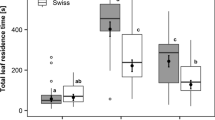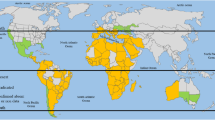Abstract
Development, reproduction, and life table parameters of the phytoseiid mite Neoseiulus idaeus Denmark & Muma preying on various stages of Tetranychus urticae Koch fed on papaya or snap bean plant were studied at 25 ± 2°C, 77 ± 2% RH and 12L:12D photoperiod. Most characteristics of the predator, including the duration of the immature stages, preoviposition and oviposition periods, and female longevity did not differ significantly among the different food combinations. During the adult stage, N. idaeus females survived up to 14 days. The net reproductive rate, the mean generation time, and the intrinsic rate of natural increase of N. idaeus were very similar on all T. urticae stage – host plant combinations, ranging from 5.15 to 6.61 females, 10.15 to 12.62 days, and 0.150 to 0.168, respectively. These results indicate that T. urticae reared either on papaya or snap bean is an adequate prey for the development and reproduction of N. idaeus. Moreover, the current findings demonstrate that the host plant of T. urticae did not affect the predator. The implications of these results for the success of N. idaeus as a biological control agent of T. urticae in papaya orchards are discussed.
Similar content being viewed by others
References
Blackwood JS, Schausberger P, Croft BA (2001) Prey-stage preference in generalist and specialist phytoseiid mites (Acari: Phytoseiidae) when offered Tetranychus urticae (Acari: Tetranychidae) eggs and larvae. Environ Entomol 30:1103–1111
Blackwood JS, Luh H-K, Croft BA (2004) Evaluation of prey-stage preference as an indicator of life-style type in phytoseiid mites. Exp Appl Acarol 33:261–280
Colfer RG, Rosenheim JA, Godfrey LD, Hsu CL (2004) Evaluation of large-scale releases of western predatory mite for spider mite control in cotton. Biol Control 30:1–10
Collier KFS, Lima JOG, Albuquerque GS (2004) Predacious mites in papaya (Carica papaya L.) orchards: in search of a biological control agent of phytophagous mite pests. Neotrop Entomol 33:799–803
Cone WW, Mcdonough LM, Maitlen JC, Burdajewicz S (1971) Pheromone studies of the twospotted spider mite. 1. Evidence of a sex pheromone. J Econ Entomol 64:355–358
Croft BA, Blackwood JS, McMurtry JA (2004) Classifying life-style types of phytoseiid mites: diagnostic traits. Exp Appl Acarol 33:247–260
de Courcy Williams ME, Kravar-Garde L, Fenlon JS, Sunderland KD (2004) The relationship between dietary specialism and availability of food and water on cannibalistic interactions among predatory mites in protected crops. Exp Appl Acarol 33:31–44
Dinh NV, Janssen A, Sabelis MW (1988) Reproductive success of Amblyseius idaeus and A. anonymus on a diet of two-spotted spider mites. Exp Appl Acarol 4:41–51
Easterbrook MA, Fitzgerald JD, Solomon MG (2001) Biological control of strawberry tarsonemid mite Phytonemus pallidus and two-spotted spider mite Tetranychus urticae on strawberry in the UK using species of Neoseiulus (Amblyseius) (Acari: Phytoseiidae). Exp Appl Acarol 25:25–36
Fernando MHJP, Hassell MP (1980) Predator-prey responses in an acarine system. Res Pop Ecol 22:301–322
Flechtmann CHW (1981) Ácaros de importância agrícola, 4th edn. Nobel, São Paulo
Fournier V, Rosenheim JA, Brodeur J, Laney LO, Johnson MW (2003) Herbivorous mites as ecological engineers: indirect effects on arthropods inhabiting papaya foliage. Oecologia 135:442–450
Gnanvossou D, Yaninek JS, Hanna R, Dicke M (2003) Effects of prey mite species on life history of the phytoseiid predators Typhlodromalus manihoti and Typhlodromalus aripo. Exp Appl Acarol 30:265–278
Holling CS (1959) Some characteristics of simple types of predation and parasitism. Can Entomol 91:385–398
Jung C, Han S, Lee J-H (2004) Release strategies of Amblyseius womersleyi and population dynamics of Amblyseius womersleyi and Tetranychus urticae. II. Test of two release rates on apple. Appl Entomol Zool 39:477–484
Kennedy GG, Storer NP (2000) Life systems of polyphagous arthropod pests in temporally unstable cropping systems. Annu Rev Entomol 45:467–493
Konno K, Hirayama C, Nakamura M, Tateishi K, Tamura Y, Hattori M, Kohno K (2004) Papain protects papaya trees from herbivorous insects: role of cysteine proteases in latex. Plant J 37:370–378
Krips OE, Witul A, Willems PEL, Dicke M (1998) Intrinsic rate of population increase of the spider mite Tetranychus urticae on the ornamental crop gerbera: intraspecific variation in host plant and herbivore. Ent Exp Appl 89:159–168
Krips OE, Kleijn PW, Willems PEL, Gols GJZ, Dicke M (1999) Leaf hairs influence searching efficiency and predation rate of the predatory mite Phytoseiulus persimilis (Acari: Phytoseiidae). Exp Appl Acarol 23:119–131
Legrand A, Barbosa P (2003) Plant morphological complexity impacts foraging efficiency of adult of Coccinella septempunctata L. (Coleoptera: Coccinellidae). Environ Entomol 32:1219–1226
McMurtry JA, Croft BA (1997) Life-styles of phytoseiid mites and their roles in biological control. Annu Rev Entomol 42:291–321
McMurtry JA, Rodriguez JG (1987) Nutritional ecology of phytoseiid mites. In: Slansky F, Rodriguez JG (eds) Nutritional ecology of insects, mites, spiders, and related invertebrates. Wiley, New York, pp 609–644
Mégevand B, Tanigoshi LK (1995) Effects of prey deprivation on life table attributes of Neoseiulus idaeus Denmark and Muma (Acari: Phytoseiidae). Biol Control 5:73–82
Moraes GJ (1992) Perspectiva para o uso de predadores no controle de ácaros fitófagos no Brasil. Pesqui Agropecu Bras 27:263–270
Moraes GJ, Alencar JA, Lima JLS, Yaninek JS, Delalibera I Jr (1993) Alternative plant habitats for common phytoseiid predators of the cassava green mite (Acari: Phytoseiidae, Tetranychidae) in northeast Brazil. Exp Appl Acarol 17:77–90
Moraes GJ, Silva CAD, Moreira AN (1994) Biology of a strain of Neoseiulus idaeus (Acari: Phytoseiidae) from Southwest Brazil. Exp Appl Acarol 18:213–220
Park YL, Lee JH (2005) Impact of twospotted spider mite (Acari: Tetranychidae) on growth and productivity of glasshouse cucumbers. J Econ Entomol 98:457–463
Pratt PD, Rosetta R, Croft BA (2002) Plant-related factors influence the effectiveness of Neoseiulus fallacis (Acari: Phytoseiidae), a biological control agent of spider mites on landscape ornamental plants. J Econ Entomol 95:1135–1141
Prischmann DA, Croft BA, Luh HK (2002) Biological control of spider mites on grape by phytoseiid mites (Acari: Tetranychidae, Phytoseiidae): emphasis on regional aspects. J Econ Entomol 95:340–347
Roda A, Nyrop J, English-Loeb G, Dicke M (2001) Leaf pubescence and two-spotted spider mite webbing influence phytoseiid behavior and population density. Oecologia 129:551–560
Sabelis MW (1985) Predation on spider mites. In: Hell W, Sabelis MW (eds) Spider mites—their biology, natural enemies and control, vol 1B. Elsevier, Amsterdam, pp 103–129
Sabelis MW (1991) Life-history evolution of spider mites. In: Schuster R, Murphy PW (eds) The Acari: reproduction, development and life-history strategies. Chapman & Hall, London, pp 23–49
Sabelis MW, Van Baalen M, Bakker FM, Bruin J, Drukker B, Egas M, Janssen ARM, Lesna IK, Pels B, Van Rijn PCJ, Scutareanu P (1999) The evolution of direct and indirect plant defence against herbivorous arthropods. In: Olff H, Brown VK, Drent RH (eds) Herbivores: between plants and predators. Blackwell, Oxford, pp 109–166
Santa-Cecília LVC, Reis PR (1986) Pragas do mamoeiro. Inf Agropec 12:49–52
SAS Institute (1985) SAS user’s guide: statistics, version 5th edn. SAS Institute, Cary, NC
Skirvin D, de Courcy Williams M (1999) Differential effects of plant species on a mite pest (Tetranychus urticae) and its predator (Phytoseiulus persimilis): implications for biological control. Exp Appl Acarol 23:497–512
Skirvin DJ, Fenlon JS (2001) Plant species modifies the functional response of Phytoseiulus persimilis (Acari: Phytoseiidae) to Tetranychus urticae (Acari: Tetranychidae): implications for biological control. Bull Entomol Res 91:61–67
Vantornhout I, Minnaert HL, Tirry L, De Clercq P (2004) Effect of pollen, natural prey and factitious prey on the development of Iphiseius degenerans. BioControl 49:627–644
Venzon M, Janssen A, Sabelis MW (2001) Prey preference, intraguild predation and population dynamics of an arthropod food web on plants. Exp Appl Acarol 25:785–808
Watanabe MA, Moraes GJ, Gastaldo I Jr, Nicolella G (1994) Controle biológico do ácaro rajado com ácaros predadores fitoseídeos (Acari: Tetranychidae, Phytoseiidae) em culturas de pepino e morango. Sci Agric 51:75–81
Wilson LJ (1993) Spider-mites (Acari: Tetranychidae) affect yield and fiber quality of cotton. J Econ Entomol 86:566–585
Yaninek JS, Mégevand B, Moraes GJ, Bakker F, Braun A, Herren HR (1991) Establishment of the neotropical predator Amblyseius idaeus (Acari: Phytoseiidae) in Benin, West Africa. Biocontrol Sci Tech 1:323–330
Acknowledgements
To Fundação Estadual do Norte Fluminense (FENORTE) for the partial financial support to develop this research and for the DS scholarship granted to the first author. To CNPq and Osvaldo K. Yamanishi (UnB), coordinator of the Integrated Production of Papaya Program, also for funding this research. To Gilberto J. Moraes (ESALQ/USP) for the mite identifications. To CNPq for grants received by the co-authors. To the three anonymous reviewers for their comments that greatly improved this manuscript.
Author information
Authors and Affiliations
Corresponding author
Rights and permissions
About this article
Cite this article
Collier, K.F.S., Albuquerque, G.S., de Lima, J.O.G. et al. Neoseiulus idaeus (Acari: Phytoseiidae) as a potential biocontrol agent of the two-spotted spider mite, Tetranychus urticae (Acari: Tetranychidae) in papaya: performance on different prey stage – host plant combinations. Exp Appl Acarol 41, 27–36 (2007). https://doi.org/10.1007/s10493-006-9041-2
Received:
Accepted:
Published:
Issue Date:
DOI: https://doi.org/10.1007/s10493-006-9041-2




